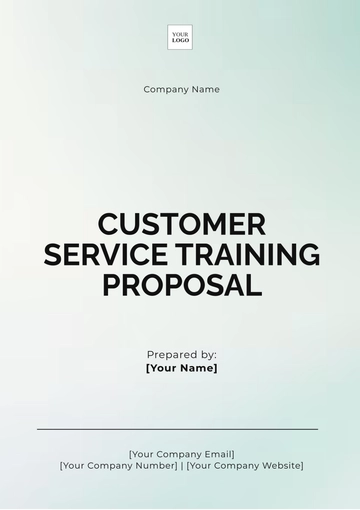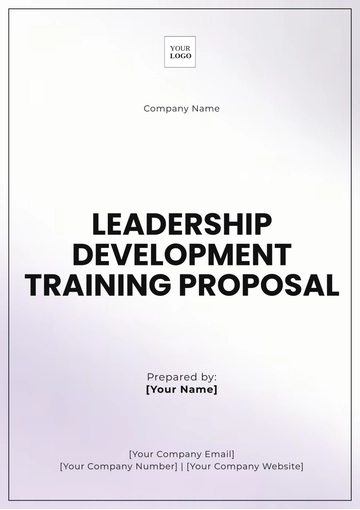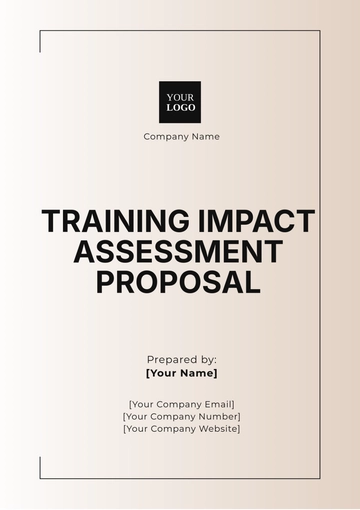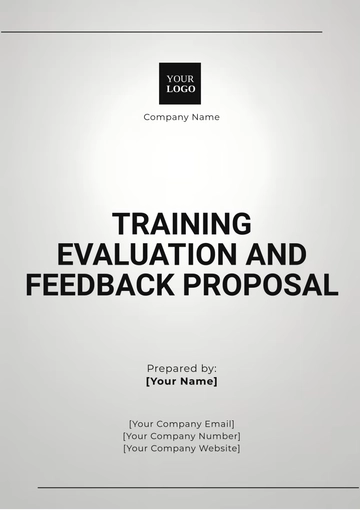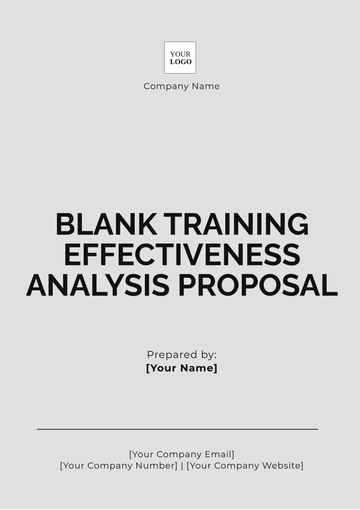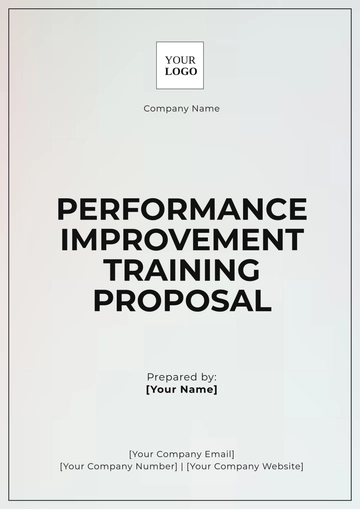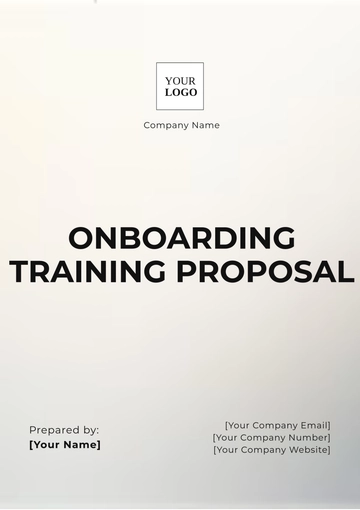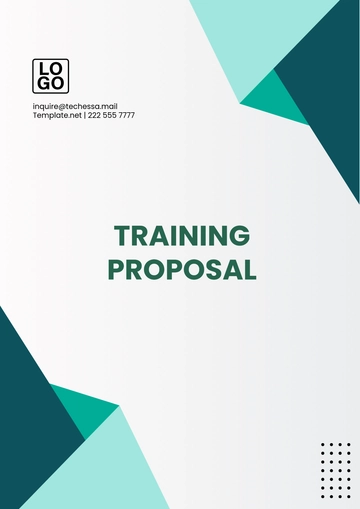Free Training Impact Assessment Proposal
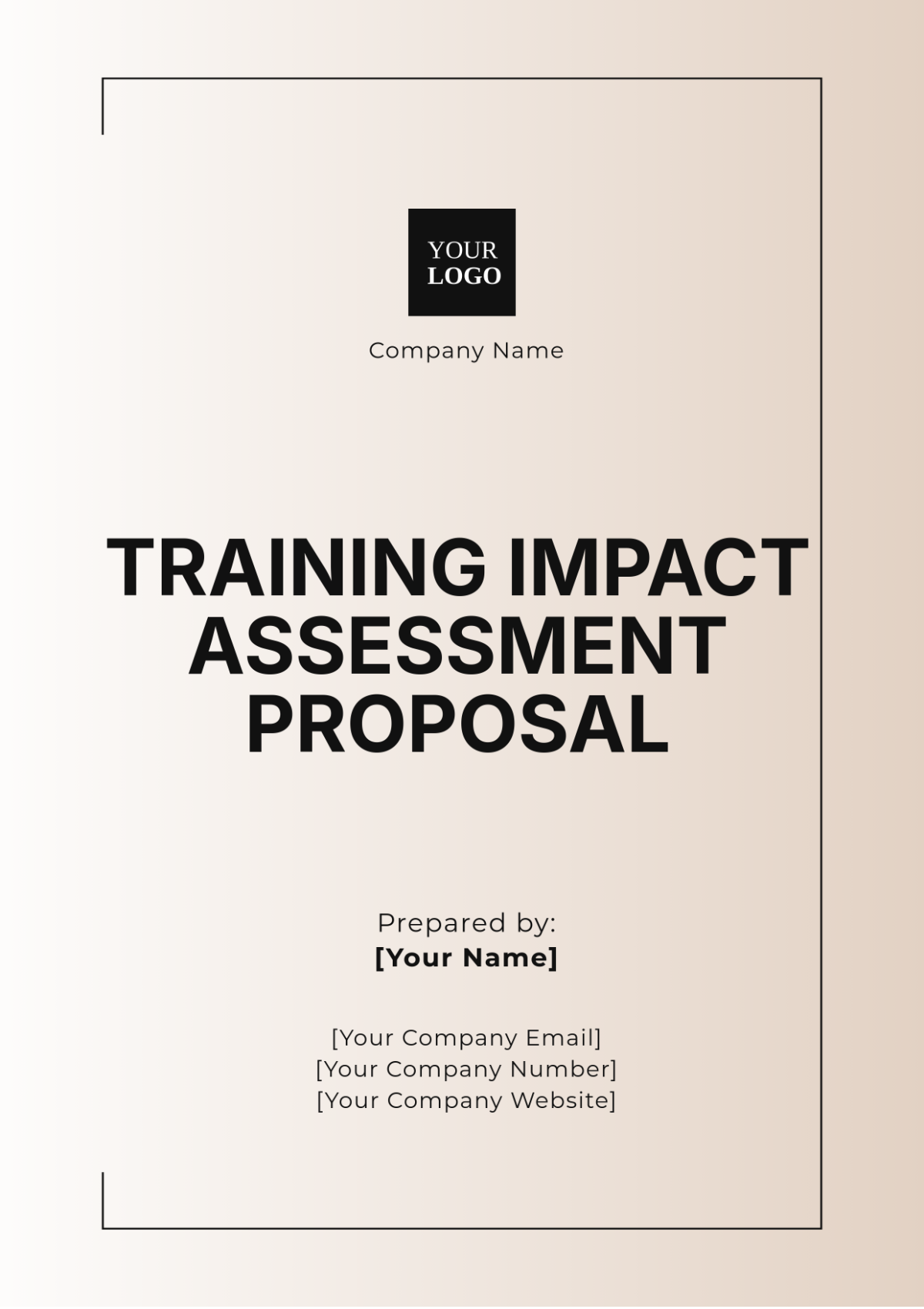
Prepared by: [Your Name]
Company: [Your Company Name]
Date: [Date]
I. Executive Summary
This proposal outlines a comprehensive plan to evaluate the effectiveness and impact of our current training program, "Elevate Training Initiative." The purpose of the assessment is to determine how well the training aligns with organizational goals, improves employee performance, and enhances overall business success. Through a structured methodology and measurable metrics, this assessment aims to provide actionable insights into the training program's effectiveness and pave the way for future improvements. By investing in this evaluation, our organization seeks to foster a culture of continuous learning and adapt our training strategies to meet evolving business needs.
II. Introduction
The contemporary business environment is dynamic, necessitating continuous learning and adaptation. Our organization has been investing significantly in training programs to enhance skills, increase productivity, and foster innovation. Understanding the impact of these training initiatives is crucial to justify expenditures and ensure alignment with strategic goals. This proposal outlines a plan for undertaking a training impact assessment to quantify the value derived from these initiatives.
A. Background
The present training program has been operational for over a year, focusing on technical skills development, leadership, and customer service excellence. While anecdotal evidence suggests improvements, such as increased team collaboration and enhanced problem-solving skills, a formal evaluation is necessary to quantify its effectiveness and impact on performance metrics.
For instance, recent feedback from team leaders indicates a 20% increase in project completion rates and a notable improvement in customer satisfaction scores. However, we require empirical data to support these claims and to facilitate informed decision-making regarding future training investments.
B. Significance
Evaluating the training program's success will not only identify areas for improvement but also underscore its value to stakeholders, cultivate a culture of learning, and guide future training investments. A thorough assessment will help us to:
Demonstrate Value: Clearly articulate the benefits of training to senior management and stakeholders.
Enhance Engagement: Foster employee engagement by involving participants in the assessment process.
Support Strategic Planning: Provide insights that inform the organization's strategic planning and workforce development initiatives.
III. Objectives
The training impact assessment aims to achieve the following objectives:
A. Evaluate Alignment
Assess how effectively the training program aligns with organizational strategic goals. This will include evaluating the relevance of training content to current business challenges and employee roles.
B. Measure Performance Improvement
Quantitatively and qualitatively analyze the performance enhancements among trainees post-training. We will focus on key performance indicators (KPIs) relevant to each department involved.
C. Determine ROI
Calculate the return on investment of the training program by comparing training costs against the financial benefits derived from improved performance.
D. Identify Areas of Improvement
Recognize strengths and weaknesses within the program to inform future training development. This may include gathering participant feedback on content, delivery methods, and overall satisfaction with the training experience.
IV. Methodology
The methodology of this assessment will be systematic, employing both qualitative and quantitative data collection techniques.
A. Data Collection
The data will be collected through the following means:
Surveys
Pre- and Post-training surveys will be administered to assess knowledge, satisfaction, and perceived applicability of the training content. For instance, questions may focus on participants' confidence in applying new skills to their daily tasks.
Interviews
Conduct in-depth interviews with a random selection of participants and managers to gather qualitative insights. This may involve structured questions regarding the training's impact on specific job functions and team dynamics.
Performance Evaluations
Analyze performance reports and KPIs before and after training interventions. This will include metrics such as sales figures, customer feedback ratings, and productivity measures.
B. Data Analysis
The collected data will be analyzed using statistical software for quantitative data and thematic analysis for qualitative data. The findings will be triangulated for validation, ensuring a comprehensive understanding of the training program’s impact. We will seek to identify correlations between training participation and measurable outcomes such as increased sales or improved customer service ratings.
V. Metrics and Measurements
The following metrics will be used to measure the effectiveness of the training program:
Metric | Description | Data Source |
|---|---|---|
Knowledge Gain | Difference in test scores before and after training | Pre- and Post-Training Tests |
Behavioral Change | Observable changes in the workplace post-training | Managerial Reports, Self-Assessments |
Performance Improvement | Increase in employee productivity and efficiency | Performance Metrics, KPIs |
Return on Investment (ROI) | Cost-benefit analysis of training expenditures | Financial Reports |
Additional Metrics
Employee Satisfaction: Assess changes in employee morale and job satisfaction pre- and post-training.
Engagement Levels: Measure participation rates in training sessions and post-training discussions to gauge employee commitment to learning.
VI. Timeline
The assessment is projected to follow this timeline:
Phase | Timeline | Activities |
|---|---|---|
Phase 1: Planning | Weeks 1-2 | Finalize objectives, methodology, and instruments. |
Phase 2: Data Collection | Weeks 3-8 | Gather data through surveys, interviews, and performance evaluations. |
Phase 3: Data Analysis | Weeks 9-12 | Compile and analyze the collected data. |
Phase 4: Reporting | Weeks 13-14 | Prepare and submit the final assessment report. |
VII. Budget
The estimated budget for this assessment includes the following components:
Item | Estimated Cost |
|---|---|
Consultant Fees | $15,000 |
Survey Tools | $2,500 |
Software Licenses | $3,000 |
Miscellaneous | $1,000 |
Total | $21,500 |
Budget Justification
The budget reflects a comprehensive approach to ensuring accurate data collection and analysis. Consultant fees cover expert guidance in training evaluation methodologies, while software licenses enable robust data analysis capabilities.
VIII. Conclusion
The execution of this training impact assessment is crucial for understanding the effectiveness, value, and areas needing improvement within our training program. By investing in this assessment, our organization can ensure that future training efforts are strategically aligned and optimized for excellence, thus driving both employee growth and organizational success. The insights gained will not only enhance our current training initiatives but also lay the foundation for a more robust, data-driven approach to employee development in the future.
This enhanced proposal provides a more detailed look into each section, giving stakeholders a clearer understanding of the assessment's purpose, methodology, and significance for the organization.
- 100% Customizable, free editor
- Access 1 Million+ Templates, photo’s & graphics
- Download or share as a template
- Click and replace photos, graphics, text, backgrounds
- Resize, crop, AI write & more
- Access advanced editor
Introducing Template.net editable and fully customizable template Training Impact Assessment Proposal Template is designed to help you evaluate the effectiveness of your training initiatives. Easily outline metrics, methodologies, and outcomes to assess the impact of your training. Tailor the template to meet your specific assessment goals, and with the editable AI Editor Tool feature, you can quickly adjust it to suit any evaluation criteria.
You may also like
- Business Proposal
- Research Proposal
- Proposal Request
- Project Proposal
- Grant Proposal
- Photography Proposal
- Job Proposal
- Budget Proposal
- Marketing Proposal
- Branding Proposal
- Advertising Proposal
- Sales Proposal
- Startup Proposal
- Event Proposal
- Creative Proposal
- Restaurant Proposal
- Blank Proposal
- One Page Proposal
- Proposal Report
- IT Proposal
- Non Profit Proposal
- Training Proposal
- Construction Proposal
- School Proposal
- Cleaning Proposal
- Contract Proposal
- HR Proposal
- Travel Agency Proposal
- Small Business Proposal
- Investment Proposal
- Bid Proposal
- Retail Business Proposal
- Sponsorship Proposal
- Academic Proposal
- Partnership Proposal
- Work Proposal
- Agency Proposal
- University Proposal
- Accounting Proposal
- Real Estate Proposal
- Hotel Proposal
- Product Proposal
- Advertising Agency Proposal
- Development Proposal
- Loan Proposal
- Website Proposal
- Nursing Home Proposal
- Financial Proposal
- Salon Proposal
- Freelancer Proposal
- Funding Proposal
- Work from Home Proposal
- Company Proposal
- Consulting Proposal
- Educational Proposal
- Construction Bid Proposal
- Interior Design Proposal
- New Product Proposal
- Sports Proposal
- Corporate Proposal
- Food Proposal
- Property Proposal
- Maintenance Proposal
- Purchase Proposal
- Rental Proposal
- Recruitment Proposal
- Social Media Proposal
- Travel Proposal
- Trip Proposal
- Software Proposal
- Conference Proposal
- Graphic Design Proposal
- Law Firm Proposal
- Medical Proposal
- Music Proposal
- Pricing Proposal
- SEO Proposal
- Strategy Proposal
- Technical Proposal
- Coaching Proposal
- Ecommerce Proposal
- Fundraising Proposal
- Landscaping Proposal
- Charity Proposal
- Contractor Proposal
- Exhibition Proposal
- Art Proposal
- Mobile Proposal
- Equipment Proposal
- Student Proposal
- Engineering Proposal
- Business Proposal


